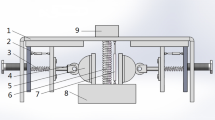Abstract
Nonlinear Quasi-zero stiffness (QZS) mechanisms were studied to overcome the weakness of linear isolators. This paper presents an integrated design of the QZS mechanism. First, various types of QZS vibration mechanisms are analyzed and a generalized model for QZS mechanisms is derived. The generalized model consists of two main parts: link and horizontal spring. The motion equation of the QZS mechanism is a Duffing equation with nonlinear stiffness. Based on the generalized model, the design problem of the QZS mechanism is converted into the kinematic design of a link element. For simplicity, the link is generalized with a cam-roller mechanism. The integrated design approach shows that the QZS mechanism can have desired QZS characteristics with properly designed cam geometry.
Similar content being viewed by others
References
C. S. Kim, K. S. Hong and M. K. Kim, Nonlinear robust control of a hydraulic elevator, Control Engineering Practice, 13 (6) (2005) 789–803.
R. A. Ibrahim, Advances in nonlinear passive vibration isolators, J. of Sound and Vibration, 314 (2008) 371–452.
C. M. Harris and A. G. Piersol, Shock and vibration handbook, 5th ed., McGraw-Hill, NY (2002).
E. I. Rivin, Passive vibration isolation, ASME Press, NY (2001).
P. Alabuzhev, A. Gritchin, L. Kim, G. Migirenko, V. Chon and P. Stepanov, Vibration protecting and measuring systems with quasi-zero stiffness, Hemisphere publishing, NY (1989).
A. Carrella, M. J. Brennan and T. P. Waters, Static analysis of a passive vibration isolator with quasi-zero-stiffness characteristic, J. of Sound and Vibration, 301 (2007) 678–689.
D. L. Platus, Negative-stiffness-mechanism vibration isolation systems, SPIE—Vibration Control in Microelectronics, Optics and Metrology, 1619 (1991) 44–54.
S. T. Park and T. T. Luu, Techniques for optimizing parameters of negative stiffness, Proc. IMechE part C: J. Mechanical Engineering Science, 221 (2007) 505–511.
K. R. Kim, Y. H. You and H. J. Ahn, Optimal design of a QZS isolator using flexures for a wide range of payload, IJPEM, 14 (6) (2013) 919–924.
A. Carrella, M. J. Brennan, T. P. Waters and V. Lopes, Force and displacement transmissibility of a nonlinear isolator with high-static-low-dynamic-stiffness, Int. J. of Mechanical Sciences, 55 (1) (2012) 22–29.
R. H. Plauta, J. E. Sidburya and L. N. Virgn, Analysis of buckled and pre-bent fixed-end columns used as vibration isolators, Journal of Sound and Vibration, 283 (2005) 1216–1228.
A. Carrella, M. J. Brennan, T. P. Waters and K. Shin, On the design of a high-static-low-dynamic stiffness isolator using linear mechanical springs and magnets, Journal of Sound and Vibration, 315 (3) (2008) 712–720.
W. Wu, X. Chen and Y. Shan, Analysis and experiment of a vibration isolator using a novel magnetic spring with negative stiffness, Journal of Sound and Vibration, 333 (13) (2014) 2958–2970.
H. J. Ahn, Performance limit of a passive vertical isolator using a negative stiffness mechanism, The Journal of Mechanical Science and Technology, 22 (12) (2008) 2357–2364.
J. Zhou, X. Wang, D. Xu and S. Bishop, Nonlinear dynamic characteristics of a quasi-zero stiffness vibration isolator with cam-roller-spring mechanisms, Journal of Sound and Vibration, 346 (23) (2015) 53–59.
N. Zhou and K. Liu, A tunable high-static-low-dynamic stiffness vibration isolator, Journal of Sound and Vibration, 329 (9) (2010) 1254–1273.
V. T. Pham, K. R. Kim and H. J. Ahn, A nonlinear control of a QZS isolator with flexures based on a Lyapunov function, IJPEM, 14 (6) (2013) 919–924.
X. T. Sun, J. Xu, X. J. Jing and L. Cheng, Beneficial performance of a quasi-zero-stiffness vibration isolator with time-delayed active control, Int. J. Mech. Sci., 82 (2014) 32–40.
T. D. Le and K. K. Ahn, A vibration isolation system in low frequency excitation region using negative stiffness structure for vehicle seat, Journal of Sound and Vibration, 330 (26) (2011) 6311–6335.
R. Ramlan, M. Brennan, B. Mace and I. Kovacic, Potential benefits of a non-linear stiffness in an energy harvesting device, Nonlinear Dynamics, 59 (4) (2009) 545–558.
X. Sun, S. Jing, C. Li and J. Xu, A 3-D quasi-zerostiffness-based sensor system for absolute motion measurement and application in active vibration control, IEEE/ASME Trans. on Mechatronics, 20 (1) (2015) 254–262.
F. Y. Chen, Mechanics and design of cam mechanisms, Pergamon Press, New York (1982).
Author information
Authors and Affiliations
Corresponding author
Additional information
Hyeong-Joon Ahn received his B.S., M.S. and Ph.D. degrees from Seoul National University, Korea in 1995, 1997 and 2001, respectively. Dr. Ahn is currently an associate professor at Dept. of Mechanical Engineering, Soongsil University. Dr. Ahn’s research interests are in the area of mechatronics, sensors, actuators, control, and precision machine design.
Sung-Hun Lim received his B.S., M.S. and Ph.D. degrees from Chonbuk National University, Korea in 1996, 1998 and 2003, respectively. Currently, he is an associate professor in the Dept. of Electrical Eng. at Soongsil Univ. Korea. Dr. Lim’s research interests are the protection relay of power systems, the superconducting fault current limiter and the power applications of superconductors.
Changkun Park received his B.S., M.S. and Ph.D. degrees in Electrical Eng. from Korea Advanced Institute of Science and Technology, Daejeon, Korea, in 2001, 2003 and 2007, respectively. In September of 2009, he joined the faculty of the School of Electronic Engineering, Soongsil Univ., Seoul, Korea. His research interests include RF and millimeter-wave circuits.
Rights and permissions
About this article
Cite this article
Ahn, HJ., Lim, SH. & Park, C. An integrated design of quasi-zero stiffness mechanism. J Mech Sci Technol 30, 1071–1075 (2016). https://doi.org/10.1007/s12206-016-0210-x
Received:
Revised:
Accepted:
Published:
Issue Date:
DOI: https://doi.org/10.1007/s12206-016-0210-x




